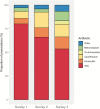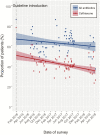Sustained Reduction in Third-generation Cephalosporin Usage in Adult Inpatients Following Introduction of an Antimicrobial Stewardship Program in a Large, Urban Hospital in Malawi
- PMID: 32060523
- PMCID: PMC7713689
- DOI: 10.1093/cid/ciaa162
Sustained Reduction in Third-generation Cephalosporin Usage in Adult Inpatients Following Introduction of an Antimicrobial Stewardship Program in a Large, Urban Hospital in Malawi
Abstract
Background: Third-generation cephalosporins (3GC) remain the first-choice empiric antibiotic for severe infection in many sub-Saharan African hospitals. In Malawi, the limited availability of alternatives means that strategies to prevent the spread of 3GC resistance are imperative; however, suitable approaches to antimicrobial stewardship (AMS) in low-income settings are not well studied.
Methods: We introduced an AMS intervention to Queen Elizabeth Central Hospital in Blantyre. The intervention consisted of a prescribing application for smartphones and regular point-prevalence surveys with prescriber feedback. We evaluate the effects of the intervention on 3GC usage and on the cost of providing antibiotics. Using a thematic analysis of semi-structured interviews and participant observations, we additionally evaluate the acceptability of the stewardship program.
Results: The proportion of antibiotic prescriptions for a 3GC reduced from 193/241 (80.1%) to 177/330 (53.6%; percentage decrease, 26.5%; 95% confidence interval, 18.7-34.1) with no change in the case-fatality rate. The cost analysis estimated an annual savings of US$15 000. Qualitative research revealed trust in the guideline and found that its accessibility through smartphones helpful to guide clinical decisions. Operational health-system barriers and hierarchal clinical relationships lead to continued reliance on 3GC.
Conclusions: We report the successful introduction of an antimicrobial stewardship approach in Malawi. By focusing on pragmatic interventions and simple aims, we demonstrate the feasibility, acceptability, and cost savings of a stewardship program where resources are limited. In doing so, we provide a suitable starting point for expansions of AMS interventions in this and other low-income settings.
Keywords: Africa south of the Sahara; antimicrobial resistance; antimicrobial stewardship.
© The Author(s) 2020. Published by Oxford University Press for the Infectious Diseases Society of America.
Figures


References
-
- Cosgrove SE, Kaye KS, Eliopoulous GM, Carmeli Y. Health and economic outcomes of the emergence of third-generation cephalosporin resistance in Enterobacter species. Arch Intern Med 2002; 162:185–90. - PubMed
-
- Cosgrove SE, Carmeli Y. The impact of antimicrobial resistance on health and economic outcomes. Clin Infect Dis 2003; 36:1433–7. - PubMed
-
- Karanika S, Karantanos T, Arvanitis M, Grigoras C, Mylonakis E. Fecal colonization with extended-spectrum beta-lactamase-producing Enterobacteriaceae and risk factors among healthy individuals: a systematic review and metaanalysis. Clin Infect Dis 2016; 63:310–8. - PubMed
-
- O’Neill J. Review on antimicrobial resistance: tackling a crisis for the health and wealth of nations. London, England: Review on Antimicrobial Resistance, 2014. Available at: https://amr-review.org/sites/default/files/AMR%20Review%20Paper%20-%20Ta.... Accessed 4 January 2020.

